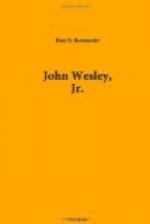The colored Methodists of Delafield, who called their church “Saint Marks,” had always been on good terms with their white co-religionists. Mr. Drury and the pastor of Saint Marks found many occasions of helping each other in their work. The single way in which these two showed themselves conscious of the color line was that while the pastor of First Church often “preached” in Saint Marks, when the pastor of Saint Marks appeared in the pulpit of First Church, it was “to speak on some aspect of his work.”
J.W. knew Saint Marks of old. In his high-school days that church had for its preacher one of a fast-vanishing race, a man mighty in exhortation, even though narrowly circumscribed in scholastic equipment. His preaching was redolent of the camp meeting, and he counted that sermon lost which did not evoke a shout or two from the front benches.
A few of First Church’s younger people often went to sing at Saint Marks on special occasions, and went all the more cheerfully because of the chance it afforded to hear Brother King Officer preach. Where he got that name is not known, but he had no other.
Do not think the young people either went to scoff or remained to pray. If at times they were amused at Brother Officer’s peculiarities, so were some members of his own flock, and Brother Officer was wise enough to assume that no disrespect was intended. And if the white visitors treated his fervent appeals to the unconverted and backsliders as part of the program, but having no slightest application to them, this was also the regular thing, and nobody was troubled thereat.
But while J.W. was away at college a new pastor had come to Saint Marks, a college and seminary graduate. And he had come just in time. Brother Officer was getting old, but the determining factor which made the change necessary was that Delafield happened to be near one of the general routes by which thousands of colored people were moving northward. “Exoduses” have been before; Kansas still remembers the exodus from Tennessee of forty years ago; but this latest exodus had no one starting-point nor any single destination. It was a vast shifting of Negro populations from below Mason and Dixon’s line, and it swept northward toward all the great industrial centers. Its cause and consequences make a remarkable story, for which there is no room in this chronicle.
Delafield thought it could not absorb many more Negroes, but before the exodus movement subsided the stragglers who had turned aside at Delafield had more than doubled the Negro population of the town.
A heavy burden of new responsibility was on the young pastor of Saint Marks. The newcomers had no such alertness and resourcefulness as his own people. They were helpless in the face of new experiences. Soon they became a worry and an enigma to the town authorities; but especially and inevitably they turned to the churches of their own color, of which Delafield could boast but two, a Methodist and a Baptist. So Saint Marks and its pastor found both new opportunity and new troubles.




